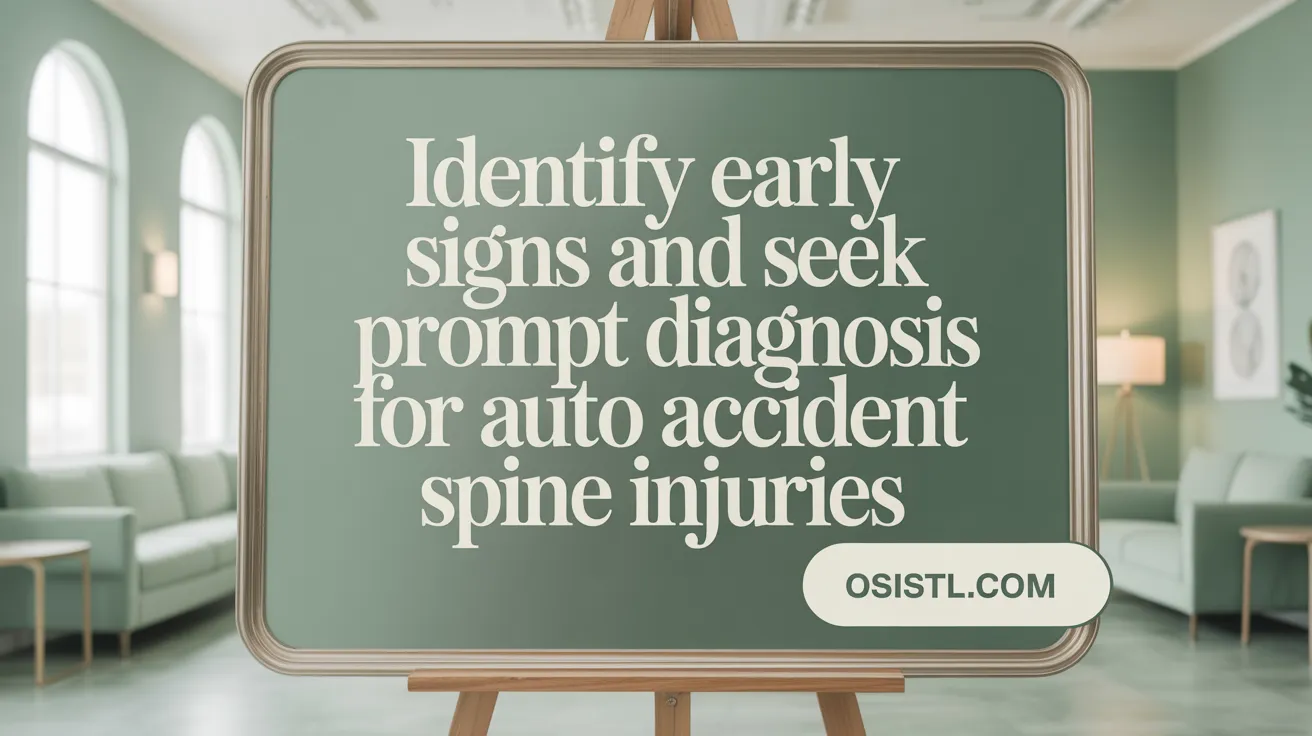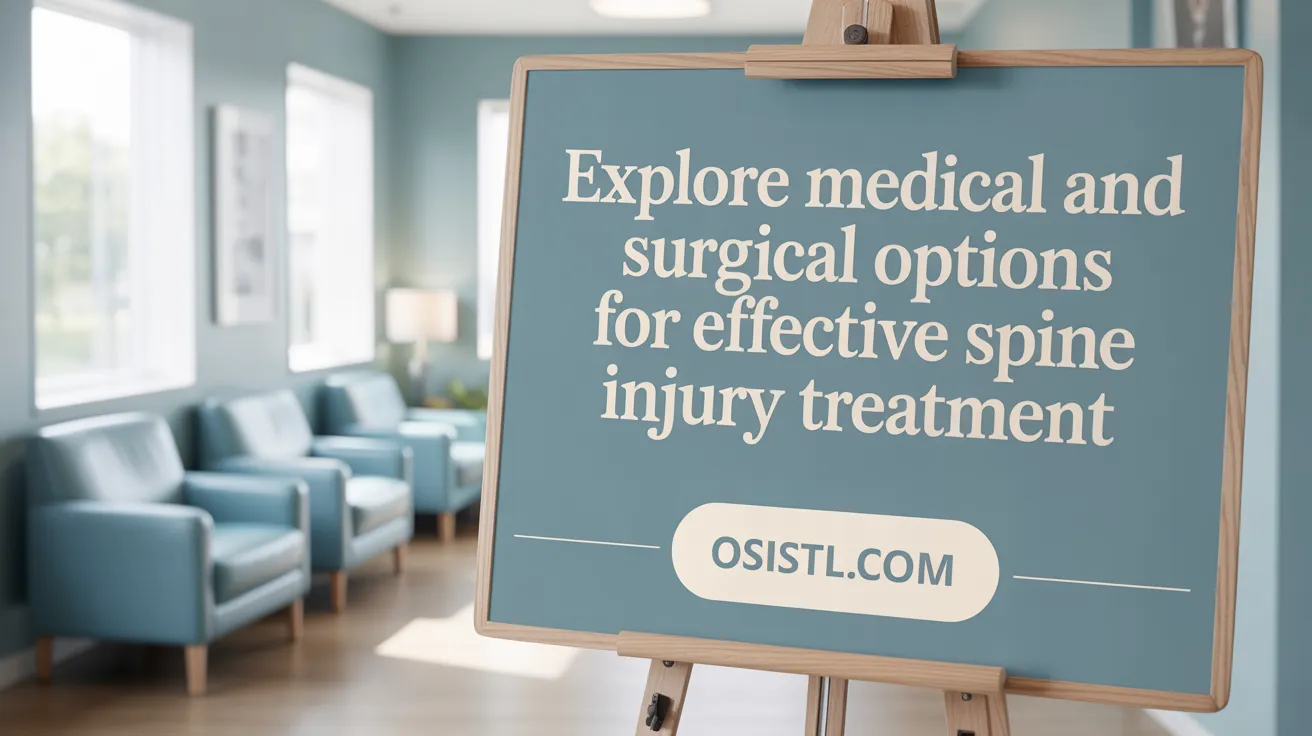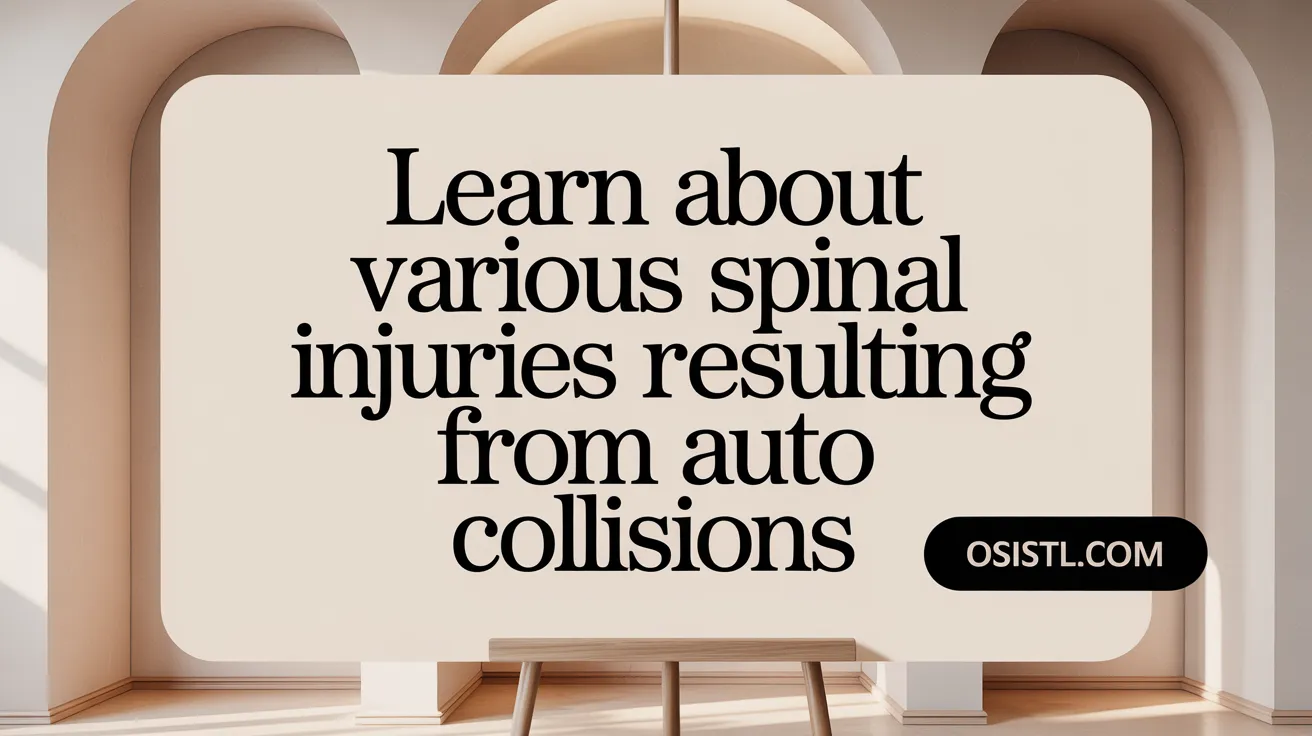Navigating the Complexities of Auto Accident Spine Injuries
Spine injuries resulting from auto accidents are a significant health concern affecting thousands each year. These injuries, ranging from minor strains to severe spinal cord damage, demand meticulous diagnosis, tailored treatment, and dedicated rehabilitation. This article explores the causes, symptoms, treatment options, recovery expectations, and preventive measures related to spinal injuries caused by vehicle collisions. Additionally, it highlights special considerations for spinal cord injury management and the essential legal and support resources available to patients. Through an integrated approach, patients and caregivers can better navigate the challenges of spine injury recovery and optimize outcomes.
Common Causes, Types, and Injury Mechanisms of Spine Injuries in Auto Accidents
Spine injuries resulting from auto accidents are common and can have serious, long-lasting impacts. These injuries are usually caused by the sudden forces exerted on the spine during a crash, such as rapid deceleration or impact. The force impacts various parts of the spine, which can lead to a range of injury types.
The most frequent injuries include vertebral fractures, which can range from minor compression fractures to severe burst fractures or dislocations. Herniated discs are also common, occurring when the impact causes the soft inner material of the disc to protrude, compressing nearby nerves and resulting in pain, weakness, or numbness.
In more severe cases, the spinal cord itself may be damaged, leading to contusions, lacerations, or complete severance. These injuries can cause paralysis or loss of sensation below the injury level. For more information, see Spinal Cord Injury Diagnosis and Treatment.
The regions most affected by auto accidents are the cervical (neck), thoracic (mid-back), and lumbar (lower back) areas. The cervical spine is especially vulnerable in rear-end collisions, leading to whiplash injuries due to hyperflexion or hyperextension. Thoracic injuries often involve compression or flexion mechanisms, while lumbar injuries tend to occur from hyperextension or rotational forces.
The biomechanics of injury play a crucial role in the type and severity of damage. Hyperflexion injuries happen when the neck or spine bends excessively forward, often causing ligament injuries and disc herniation. Hyperextension injuries involve backward bending, risking facet joint injuries and fractures. Compression injuries occur when axial forces force the vertebrae together, risking fractures or burst injuries. Rotation adds torsional stress, which can result in dislocations or tears in ligaments and muscles.
Understanding these causes, injury types, and mechanisms can help in prompt diagnosis and targeted treatment post-accident. Recognizing the common injury patterns and the biomechanics involved underscores the importance of proper restraint use, seat belt safety, and vehicle safety features in preventing severe spine injuries during crashes. For detailed information on common spinal injuries in car accidents and treatment options, see the provided resources.
Recognizing Symptoms and Diagnostic Indicators of Auto Accident Spine Injuries
 Spinal injuries resulting from auto accidents often present with a range of symptoms that require immediate medical attention. Common signs include severe neck or back pain, numbness or tingling sensations, muscle weakness, and in some cases, paralysis. Autonomic dysfunction such as loss of bladder or bowel control can also indicate significant injury.
Spinal injuries resulting from auto accidents often present with a range of symptoms that require immediate medical attention. Common signs include severe neck or back pain, numbness or tingling sensations, muscle weakness, and in some cases, paralysis. Autonomic dysfunction such as loss of bladder or bowel control can also indicate significant injury.
During physical examinations, healthcare providers look for physical signs like decreased reflexes, motor deficits, and sensory loss. In emergency situations, indicators such as difficulty breathing or a visibly twisted or immobilized neck or back signal urgent need for intervention.
Diagnostic imaging tools play a vital role in confirming spinal injuries. X-rays are typically used first to detect fractures or dislocations. For more detailed visualization of bone structures and disks, CT scans provide cross-sectional images that help assess complex injuries. MRI scans are essential for evaluating soft tissue damage, including spinal cord involvement, nerve compression, and ligament injuries.
In addition to imaging, neurological exams and electromyography (EMG) are employed to assess nerve function and determine the severity of the injury. These tests help classify injuries according to standards like the ISNCSCI scale, which guides prognosis and treatment planning.
Prompt recognition of symptoms, thorough physical assessment, and appropriate imaging are critical. Immobilizing the spine immediately and initiating emergency care can prevent further damage. Early diagnosis allows for timely intervention, which is crucial for improving recovery prospects and minimizing long-term disabilities in auto accident-related spinal injuries. See more about Emergency care for spinal injuries and Spinal cord injury causes and prognosis.
Medical and Surgical Treatments for Auto Accident Spine Injuries

What medical and surgical treatment options exist for spinal injuries caused by auto accidents?
Spinal injuries resulting from auto accidents require prompt and tailored treatment based on the injury's severity and specific characteristics. Initial management focuses on immobilization to prevent further damage. Healthcare providers typically use braces, cervical collars, or traction to stabilize the spine immediately after the injury occurs. This helps protect the spinal cord and minimizes secondary injury. For detailed information on Spine immobilization techniques and emergency care for spinal injuries.
In cases of severe trauma, surgical intervention is often necessary. Common surgical procedures include decompression, where part of the vertebral bone or herniated disc tissue is removed to relieve pressure on the spinal cord or nerves. Spinal surgery options include spinal fusion, which involves permanently joining two or more vertebrae with bone grafts, sometimes reinforced with metal rods and screws, to stabilize the spine. This procedure is especially useful in cases of instability or fractures. Learn more about common spinal surgeries after car accidents and surgical treatments for spinal injuries.
Medications also play a vital role in managing pain and inflammation associated with spinal injuries. NSAIDs and muscle relaxants are frequently prescribed. However, the routine use of corticosteroids such as methylprednisolone is no longer recommended due to concerns over side effects and limited benefit in current clinical practice. See more on spinal injury medication and anti-inflammatory medication for back pain.
Postoperative care includes physical therapy and rehabilitation to restore function, reduce pain, and prevent secondary complications like pressure ulcers or blood clots. Advanced treatments such as nerve regeneration therapies are under research, exploring possibilities to improve the prognosis of severe spinal cord injuries. For rehabilitation, physical therapy for spinal injury, and spinal cord injury rehabilitation programs provide comprehensive approaches.
Recovery outcomes depend on injury type and promptness of treatment, with comprehensive care plans aimed at maximizing independence and quality of life for injured individuals. For a broader understanding of treatment options for spinal injuries and long-term care for spinal injury patients.
Rehabilitation and Physical Therapy Strategies for Spine Injury Recovery

What rehabilitation strategies and physical therapy approaches help in recovering from spinal injuries?
Rehabilitation after a spinal injury adopts a holistic and multidisciplinary approach that focuses on restoring as much function and independence as possible. The process begins with an initial assessment by a team of specialists, including physiatrists, physical therapists, occupational therapists, psychologists, and other healthcare providers. Their goal is to tailor a personalized rehabilitation plan suited to the individual's injury level, severity, and overall health (Spinal Cord Injury Rehabilitation at Mount Sinai, Rehabilitation after spinal cord injury, Spinal Cord Injury Rehabilitation).
Physical therapy plays a pivotal role in this recovery journey. It includes exercises designed to strengthen muscles, improve flexibility, and enhance joint mobility. Core strengthening exercises, such as pelvic tilts, bridges, and planks, help stabilize the spine and reduce pain. Stretching routines like hamstring and hip flexor stretches promote flexibility, which can alleviate tension and prevent contractures (Physiotherapy management of spinal cord injury, Physical therapy for low back pain, Spine pain causes and therapeutic exercises).
In addition to traditional exercises, early mobilization techniques are employed, such as passive range-of-motion exercises and positioning to prevent complications like pressure ulcers and muscle atrophy. As the patient progresses, active resistance training and functional exercises are introduced to rebuild strength and coordination (Rehabilitation of spinal cord injuries, Locomotor training for spinal cord injury).
A notable advancement in spinal injury rehabilitation is locomotor training. This involves treadmill walking with body-weight support, robotic-assisted gait training, and electrical stimulation therapies. These modalities aim to activate neural circuits that can promote nerve regeneration and recover walking ability, especially in incomplete injuries (Locomotor training for spinal cord injury, Spinal Cord Injury Rehabilitation at Mount Sinai).
Occupational therapy is integral to helping patients regain skills for daily living activities, such as feeding, grooming, and dressing. It also involves training in the use of assistive devices and implementing environmental modifications at home and work to promote safety and independence (Spinal Cord Injury Rehabilitation at Mount Sinai, Spinal cord injury rehabilitation).
Assistive technologies, including powered wheelchairs, adapted driving controls, and communication devices, further support functional independence. Incorporating these into rehabilitation fosters a more comprehensive recovery and supports community reintegration (Physiotherapy management of spinal cord injury, Spinal Cord Injury Rehabilitation Program).
Overall, successful rehabilitation hinges on early initiation, active participation, and a coordinated team approach. Ongoing research into neuroplasticity and advanced therapies continues to enhance recovery prospects, helping individuals regain movement and improve quality of life (Rehabilitation of spinal cord injuries, Spinal cord injury treatment, Spinal Cord Injury Rehabilitation Program).
Recovery Timeline, Prognosis, and Influencing Factors in Auto Accident Spine Injuries
What is the typical recovery timeline and prognosis for auto accident-related spinal injuries, and which factors influence healing?
The time it takes to recover from spinal injuries caused by auto accidents varies greatly based on the severity and type of injury. Mild injuries such as whiplash or soft tissue strains often resolve within days to weeks with conservative treatment like physical therapy, rest, and medication.
More serious conditions, such as herniated discs or vertebral fractures, may take several weeks to a few months to heal, especially with targeted interventions like injections or surgery. Severe injuries, including spinal cord damage, often require extensive rehabilitation and can involve long-term or lifelong management. For more details on types and treatments of spinal injuries from car accidents, see Common spinal injuries in car accidents.
Most functional recovery occurs within the first 18 months after injury. During this period, patients often see the greatest gains in mobility, strength, and independence. However, some individuals experience improvements beyond this window, particularly with ongoing therapy and technological aids available for spinal cord injury, as described in Physiotherapy management of spinal cord injury and Spinal Cord Injury Rehabilitation at Mount Sinai.
Several factors influence the healing process:
- Extent of damage: Complete injuries tend to have a poorer prognosis than incomplete injuries where some nerve function remains, explained in Spinal cord injury causes and recovery factors
- Timeliness of treatment: Early stabilization, diagnosis, and intervention can markedly improve outcomes, as detailed in Spinal cord injury diagnosis and treatment
- Patient's overall health: Younger individuals and those in good health generally recover faster.
- Rehabilitation adherence: Consistent participation in therapy and rehabilitation programs enhances recovery possibilities, outlined in Outpatient physiotherapy care for spinal injury and Spinal Cord Injury Rehabilitation
Overall, prognosis depends on injury specifics, early and customized care, and active engagement in recovery efforts. While some patients regain sufficient function for independence, others may require long-term support and adaptive devices, discussed in Spinal Cord Injury Rehabilitation Program and Rehabilitation after spinal cord injury.
Prevention Tips and Exercises to Maintain Spinal Health and Avoid Injuries
Protecting your spine involves a mix of good daily habits and specific exercises designed to strengthen and stretch the muscles supporting your back.
Starting with posture and ergonomics, it’s essential to maintain proper alignment while sitting, standing, and lifting. Using ergonomic chairs and supports can reduce undue stress on the spine. When lifting heavy objects, bend at the hips and knees rather than the waist, and avoid twisting your body.
Core strengthening exercises are vital for spinal stability. The plank, bird-dog, and bridges are effective routines that activate deep abdominal and back muscles. These exercises not only bolster support for your spine but also help prevent strains and disc injuries. For more guidance, see Spine Injury Prevention Exercises.
Flexibility is equally important. Gentle stretches like knee-to-chest, seated spinal twists, and hamstring stretches improve range of motion and reduce stiffness. Regularly incorporating these into your routine can alleviate tension, especially after prolonged sitting or activity.
In addition to targeted exercises, activity modifications and ergonomic supports make a significant difference. Using lumbar rolls, adjustable desks, and supportive footwear can minimize repetitive stress and strain. Find more information on Preventative Physical Therapy.
Lifestyle approaches such as participating in yoga, which combines stretching and strengthening, are beneficial. Yoga enhances posture, promotes relaxation, and increases flexibility.
Lastly, avoiding risky behaviors like poor lifting techniques, high-impact sports without proper training, or smoking — which impairs blood flow to spinal tissues — supports long-term spinal health.
Consistent practice of these exercises and habits, complemented by proper posture, activity adjustments, and a healthy lifestyle, can markedly decrease the risk of spinal injuries and maintain your back’s health over time. For additional safety and recovery insights, see Common Back Injuries from a Car Accident.
Special Considerations in Managing and Rehabilitating Spinal Cord Injuries
What special considerations are involved in managing and rehabilitating spinal cord injuries?
Managing and rehabilitating spinal cord injuries (SCI) requires a comprehensive, multidisciplinary approach that adapts to the specific severity, location, and stage of the injury. In the acute phase, the primary goal is to prevent secondary complications such as respiratory problems, pressure ulcers, blood clots, and neurogenic shock. This involves immediate stabilization of the spine through immobilization, emergency interventions like surgery if necessary, and vigilant monitoring of vital signs.
As the patient progresses into subacute and chronic phases, therapy shifts focus towards maximizing functionality and independence. Advanced treatments including electrical stimulation, robotic-assisted gait training, and functional electrical stimulation aim to stimulate nerve regeneration and improve motor and sensory functions. Rehabilitation strategies are tailored to address motor deficits, sensory loss, bladder and bowel management, and psychological well-being as discussed in physiotherapy management of spinal cord injury.
Long-term care encompasses ongoing multidisciplinary support, such as psychological counseling, community reintegration programs, and home environment modifications. Managing risks like respiratory infections, circulatory issues, and pressure injuries is vital for maintaining quality of life, as highlighted in managing complications of spinal cord injury.
Emerging evidence supports the use of innovative technologies and surgical techniques to enhance outcomes. For instance, neurostimulation devices and robotics are increasingly integrated into therapy plans. Additionally, continuous assessment and adaptation ensure that care remains responsive to the evolving needs of individuals with SCI, as described in spinal cord injury rehabilitation programs.
Overall, successful rehabilitation hinges on early intervention, personalized planning, and continuous support—aiming to restore as much function as possible and empower individuals to reclaim their independence. For a thorough overview of spinal cord injury rehabilitation, please refer to specialized rehabilitation centers which provide multidisciplinary rehab teams and advanced rehabilitative technologies.
Legal Rights, Healthcare Resources, and Support Options for Auto Accident Spine Injury Patients
 Individuals who sustain spinal injuries from auto accidents are entitled to a range of legal and healthcare resources designed to support their recovery and long-term well-being. Legally, they have the right to seek compensation for medical costs, rehabilitation expenses, assistive devices, home modifications, and lost wages through personal injury claims or insurance litigation. Consulting experienced attorneys can help navigate the complex legal landscape, ensuring fair settlement and protection of rights.
Individuals who sustain spinal injuries from auto accidents are entitled to a range of legal and healthcare resources designed to support their recovery and long-term well-being. Legally, they have the right to seek compensation for medical costs, rehabilitation expenses, assistive devices, home modifications, and lost wages through personal injury claims or insurance litigation. Consulting experienced attorneys can help navigate the complex legal landscape, ensuring fair settlement and protection of rights.
Access to specialized rehabilitation facilities is crucial for maximizing recovery outcomes. These centers offer advanced therapies such as robotic gait training, neurostimulation, and comprehensive physical and occupational therapy tailored to spinal cord injury patients. Additionally, support groups and counseling services are available to address emotional and psychological challenges, promoting mental health and social reintegration.
Community resources are vital for providing financial assistance, disability benefits, and adaptive technology. Support programs often include case management services to coordinate care, facilitate access to assistive devices, and guide home modifications for safety and accessibility. Educational programs and peer mentorship further empower patients to manage their condition effectively.
In summary, the combination of legal rights to compensation, specialized medical care, emotional support, and community services forms a comprehensive framework that helps individuals with spinal injuries from auto accidents recover physically, emotionally, and socially. Staying informed about these options is essential for effective rehabilitation and quality of life.
Understanding Common Types of Spinal Injuries from Auto Accidents in Detail

Whiplash injury specifics and symptoms
Whiplash is the most common spinal injury after a car accident. It occurs when the head and neck are suddenly jerked forward and backward, stretching and damaging tendons, ligaments, and muscles. Symptoms vary from mild neck stiffness and pain to severe neurological effects, including headaches, dizziness, numbness, and tingling. Often, whiplash causes muscle spasms and discomfort that can take days or weeks to fully resolve. Early treatment with immobilization, physical therapy, and anti-inflammatory medications helps prevent chronic pain and long-term issues. For more details, see Whiplash injury overview.
Herniated and ruptured discs and their effects
Herniated discs happen when the soft gel center of an intervertebral disc leaks out through a tear in the outer layer. This injury often results from the impact during a collision. Symptoms include radiating pain, weakness, numbness, or shooting sensations down the arms or legs. Herniated discs can compress nearby nerves, causing discomfort and functional impairments. Without proper treatment, these injuries may develop into chronic pain conditions, nerve irritation, or nerve damage that affects mobility. More information is available about Herniated discs post-accident and Herniated discs from car accidents.
Vertebral fractures and related neurological consequences
Broken vertebrae are common in car accidents, especially in the lumbar and thoracic regions. These fractures can cause significant pain, swelling, bruising, and in severe cases, shift the vertebrae, leading to spondylolisthesis. Such injuries may compress the spinal cord or nerves, resulting in neurological symptoms like paralysis, muscle weakness, or loss of bladder/bowel control. Immediate stabilization and treatment, which may include surgery, are critical to prevent permanent nerve damage. See more on Vertebral fractures explained and Broken vertebrae and spondylolisthesis.
Facet joint injuries and spinal stenosis
Trauma from a collision can also damage the facet joints, which connect the vertebrae. Injuries to these joints cause pain and restrict mobility. Car accidents can worsen or trigger spinal stenosis, a condition where the spinal canal narrows, putting pressure on the spinal cord and nerves. Symptoms include persistent pain, numbness, weakness, and difficulty walking. Untreated injuries to the facet joints and spinal canal can lead to long-term pain and reduced quality of life. Learn more about Facet joint injuries and Spinal Stenosis After Car Accidents.
Risks of untreated injuries leading to chronic pain or disability
Failing to address spinal injuries after a car accident can have serious consequences. Untreated whiplash, herniated discs, vertebral fractures, or facet joint injuries may develop into chronic pain, nerve irritation, or permanent nerve damage. These complications can cause persistent mobility issues, sensory deficits, and even disabilities affecting daily life and work. Prompt diagnosis and treatment are essential to prevent long-term disability and ensure proper recovery. For comprehensive treatment options, see Treatment options for back injuries and Physical therapy for spinal injuries.
Home Care and Early Management Strategies Post Auto Accident Spine Injury
Initial symptom management at home
After a car accident, it's common to experience back or neck pain that can be managed at home in the initial stages. Rest is crucial, but it’s equally important to avoid inactivity that can worsen stiffness or weakness. Using over-the-counter pain relievers like NSAIDs can help reduce discomfort, but always follow medical advice (Back Pain Treatments After Car Accidents, Pain after a car accident).
Activity restrictions and proper rest
Limiting physical activity is essential to prevent further injury or inflammation. Avoid heavy lifting, strenuous movements, or awkward positions. Proper rest involves sleeping in positions that support the spine—preferably on a firm mattress with supportive pillows—and avoiding prolonged sitting or standing (Activity modification for back pain, Proper sleeping positions for back pain).
Applying ice and heat therapy correctly
Ice packs are effective during the first 48 hours after injury to minimize swelling and numb sharp pains. Wrap ice in a cloth before applying to the injured area for 15-20 minutes every few hours.
Heat therapy, such as warm compresses or heating pads, can be used after the initial swelling subsides to relax muscles and improve blood flow. Apply heat for 15-20 minutes but avoid sleeping with heat sources to prevent burns (Ice and heat therapy).
Importance of medical evaluation within two weeks
While home care is beneficial, it’s vital to get a professional medical evaluation within two weeks following the injury. An orthopedic specialist or spine doctor can assess for hidden injuries such as fractures or herniated discs and recommend appropriate treatments. Early diagnosis can prevent minor issues from becoming chronic (Common causes of back pain following a collision, Types of back injuries from car accidents, Diagnosis methods for spinal injuries).
Preventing chronic pain and long-term complications
Ignoring persistent pain or symptoms may result in long-term problems like nerve damage, degenerative changes, or chronic pain syndromes. Following medical advice, attending follow-up appointments, and adhering to prescribed therapies are vital. Engaging in gentle, doctor-approved exercises and avoiding risky activities supports recovery and reduces the likelihood of long-term disability (Risks of untreated back injuries, Chronic pain due to back injury, Nerve damage from back trauma, Physical therapy for back pain).
Moving Forward After Auto Accident Spine Injury
Spinal injuries from auto accidents pose complex challenges that necessitate prompt diagnosis, customized treatment, and comprehensive rehabilitation efforts. Understanding causes, recognizing symptoms early, and pursuing multidisciplinary care can markedly improve recovery trajectories. Preventative strategies and spinal health maintenance further aid in minimizing future injury risk. Additionally, navigating legal rights and utilizing available healthcare and community resources provide critical support. Through coordinated medical management, patient dedication, and supportive networks, individuals affected by spine injuries can enhance functional outcomes and rebuild quality of life.
